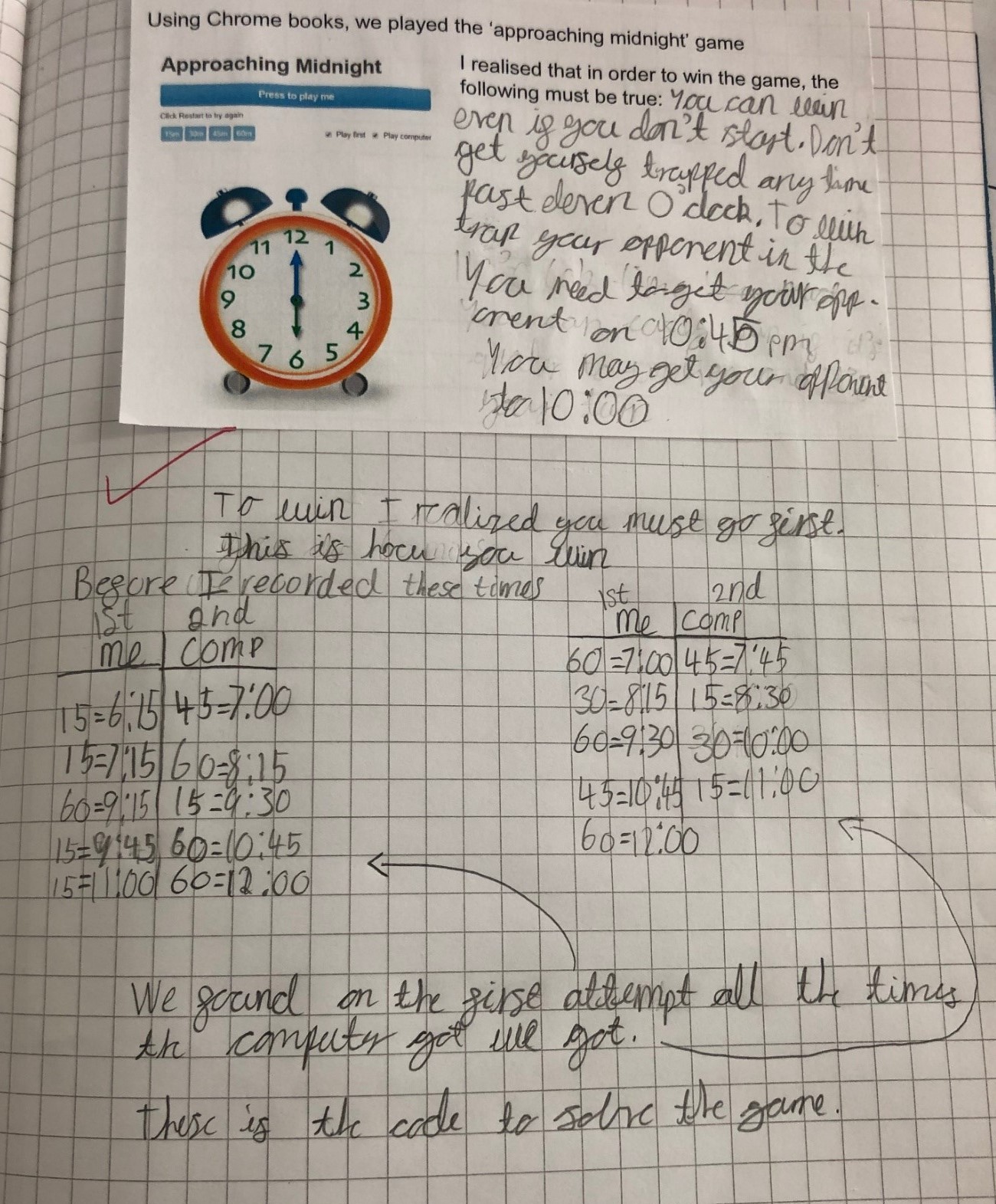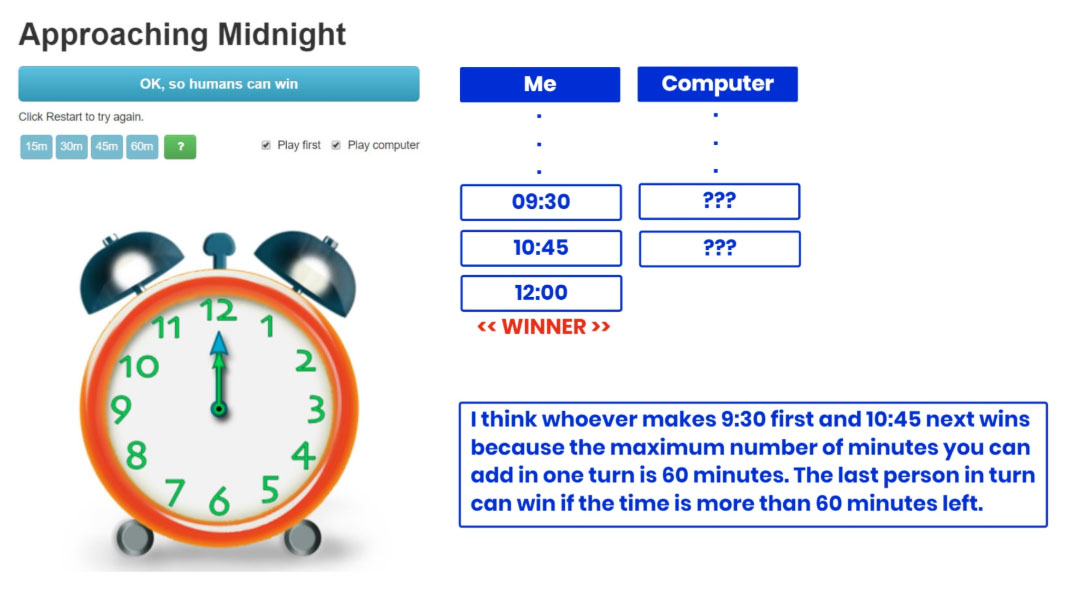Or search by topic
Number and algebra
Geometry and measure
Probability and statistics
Working mathematically
Advanced mathematics
For younger learners
Approaching Midnight Jump Straight In
- Problem
- Student Solutions
Thank you to everybody who submitted a solution to this task. We received a lot of comments from children who were frustrated that the computer always seemed to win!
Martin from Trinity Grammar School in Australia had an idea for how likely they were to win:
I think it could be 50 50 for each player to win.
Good idea, Martin - often with two-player games, each player does have a roughly equal chance of winning. The solutions we received from children who played against other children said that each player won about half the time. The solutions we were sent by children who played against the computer said that the computer tended to always win until the children had worked out a winning strategy!
Some children looked carefully at how the computer won the game, then copied that strategy. Dexter from Stapleford Primary in the UK said:
In class, I saw the computer always ends its turn at 7:00, 8:15, 9:30 and 10:45 so I turned that into a way to win in the normal settings without fail. You want to start with 60 minute time change to 7:00 then the computer will play. From there you add however much time you need to get to 8:15. You do the same again with 9:30 and 10:45 and after that, you can win always if you use this strategy.
Well spotted, Dexter! Kiran from Chipstead Valley Primary School in England drew a table to keep track of the times the computer chose, and used that to beat the computer:

Well done for looking really carefully at the times chosen by the computer. Kiran also found that the times 7:00, 8:15, 9:30 and 10:45 were the key to winning this game.
Kim from BIS HCMC in Vietnam started to explain why these times are important:

Thank you for sending in that picture, Kim. I wonder why having the maximum set to 60 minutes might make those times important?
Joon from BIS HCMC focused on explaining why it is possible to win if you get the computer to 10:45:
My strategy is to make the computer's turn be at 10:45 first. If the computer approaches 10:45, the computer has to choose one of 15mins, 30mins, 45mins, 60mins. After then I will choose 60mins, 45mins, 30mins, 15mins, and I can always win.
Well spotted, Joon - this explains clearly why 10:45 is an important time in this game.
Nisantika also worked through all of the possibilities to convince us why 10:45 is an important time:
If we have set the time of our clock to 10.45 in our last turn, regardless of our opponent's steps we will be able to make the clock strike midnight, after the opponent's turn.
So, if my opponent takes the following steps after I made the clock strike 10.45, here's what I can do:
I. If he rotates the clock hands by 15 minutes, the time on the clock shall be 10.45 + 15 minutes = 11 o'clock. We can easily rotate the clock's hands by 60 minutes and win.
II. If he rotates it by 30 minutes, the clock will show 10.45 + 30 minutes = 11.15pm. We can easily rotate the hands by 45 minutes to win.
III. If he rotates it by 45 minutes, then the time on the clock will be 10.45 + 45 minutes = 11.30 pm. So, it is obvious that we can rotate the hand by 30 minutes to win.
IV. Once again, if he rotates it by 60 minutes, the time on the clock will be 10.45 + 60 minutes = 11.45pm. We can rotate the hand by 15 minutes to win.
These are good ideas, Nisantika!
Nisantika kept working backwards from 10:45 to show that 9:30 is an important time:
The winning strategy is to set the clock to 10.45 in our 2nd last chance, to do which we must set the clock to 9.30 in our 3rd last chance.
If we are able to set the time of the clock to 9.30 in our 3rd last chance, then, regardless of whatever step our opponent takes, we can bring it to 10.45 in our 2nd last chance.
I wonder if we could keep working backwards to show that 8:15 is an important time? What about 7:00?
Archisman from The Future Foundation School in India noticed how all of these times are related to each other:
Starting first, you should move 60 mins forward. Then after that every round's total time should be equal to 75 mins, like if the clock does 60, you do 15, so the total is 75. You should win.
Well spotted, Archisman. I wonder why the round's total times have to equal 75 minutes in the winning strategy?
Parzaan, also from The Future Foundation School, sent in this explanation:
We need to turn the clock, at first to 7:00, then to 8:15, then to 9:30, then to 10:45 and at last to 12:00. After 7:00, no matter what the opponent plays, when the minimum time that can be increased is 15 minutes and the maximum time that can be increased is 60 minutes, we will win because even if the opponent increases the current time by the minimum amount of time (i.e. 15 minutes) the next suitable time slot after 7:00, according to me (i.e. 8:15, 9:30 or 10:45) can be reached by me. I figured this out by subtracting at first the maximum amount of time that can be increased (i.e. 60 minutes) from 12:00 and subtracting the minimum amount of time that can be increased (i.e. 15 minutes) and I kept on subtracting 75 minutes (60 minutes+15 minutes) from 12:00, until I reached 7:00.
Well done for explaining this, Parzaan - it looks like 75 minutes is an important total time because it is the maximum time increase (60 minutes) added to the minimum time increase (15 minutes). I wonder why this makes it important in the game?
Jerry from BIS HCMC gave a similar explanation:
If your biggest number for example is 60 minutes, add 15 because that means the AI has to go for a number but it can't reach the number 1h 15m and if you keep adding it it will reach 12H Midnight.
This is a helpful way of thinking about it, Jerry - the computer can't reach 1 hour and 15 minutes on its turn, but you can always add something to the computer's turn to get to 1 hour and 15 minutes in total.
We also received some excellent solutions from: P6 from Newhill in Scotland; Aratrik and Sayan from The Future Foundation School in India; Sohana from Beech Hill School in Halifax, England; Josh from Heron Way School in the UK; Saul from Fairfield in England; Mia from Channing in England; Shayan from Elrick School in the UK; Samuel from St. Peter's C.E. School in the UK; Lee, Rayden, Hannah, Katie, Hyun, Nathan, Andrew, Sophie, Mariia, Bie from BIS HCMC in Vietnam; and the children at Chipstead Valley Primary School in England. Thank you all for sending in your ideas.
You may also like
Tea Cups
Place the 16 different combinations of cup/saucer in this 4 by 4 arrangement so that no row or column contains more than one cup or saucer of the same colour.
Exploring Wild & Wonderful Number Patterns
EWWNP means Exploring Wild and Wonderful Number Patterns Created by Yourself! Investigate what happens if we create number patterns using some simple rules.

